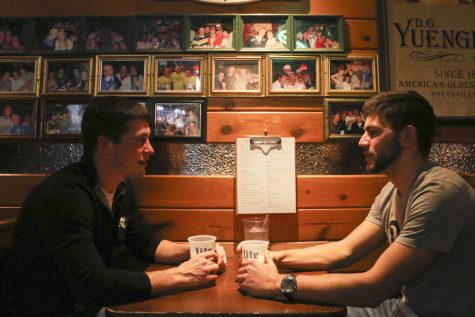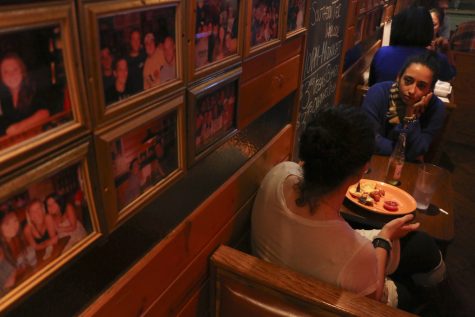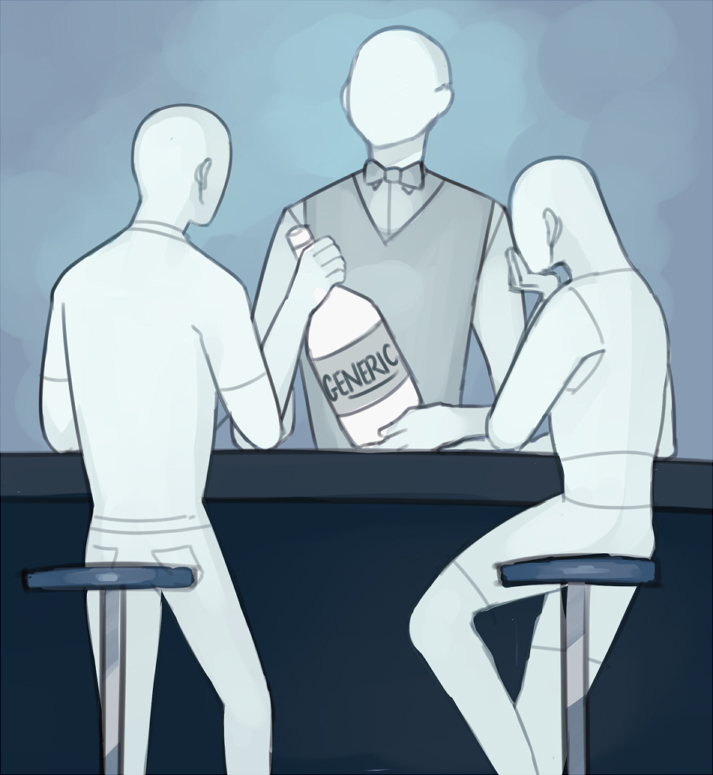This is part two of a series by staff writer Stephen Caruso about how Oakland’s businesses and the community have changed since the 1990s — for better or worse. Stay tuned for the next installment, which will be about Oakland’s community improvement initiatives. For part one of the series, click here.
After a long week of term papers and 9 a.m. classes, Pitt students in the 1990s had a pitcher full of options when they needed to knock back brews and let loose to Spice Girls or Biggie Smalls.
Pitt ’96 grad Christine Mattiko would spend those reckless college nights at Calico’s, a bar where Fuel and Fuddle is today. Every Thursday, Calico’s offered a deal Mattiko, or any money-starved college student, couldn’t turn down — nickel drafts.
“[You’re] rubbing two quarters together like, ‘I’m going to get wasted,’” Mattiko said.
Since returning with her husband and kids, Mattiko is delighted by a few changes. Schenley Plaza’s transformation from a gray lot filled with cars to a bright green park with studious sunbathers in the mid-2000s comes to her mind.
But as Oakland has matured over the past 20 years, it has traded dive bars and longtime rock joints for corporate fast food and student housing, leaving alums longing for their college nights.
Business owners take the change as a blank check for higher quality and more specialized drinks and food — with higher prices — while many Pitt students might be happier with bargains and a variety of choices for fun nights out.
A parent herself, and a proud alum, Mattiko is content to let go of her memories though, if it means a thriving, more vibrant Oakland for her children.
“You have these memories of things that may have happen, but it’s good to see the universities keeping up with the time so kids still want to go there,” Mattiko said.

Then
According to Scott Kramer, in the 1990s, Pitt students had a lot of ways to amuse themselves on Forbes Avenue.
“[Oakland] used to be an entertainment district,” Kramer said, mentioning bowling alleys, cinemas, live theater and enough bars — with names like CJ Barney’s, Laga, Zelda’s Greenhouse and Sanctuary — to comfortably hop from pitcher to pitcher on a cool Pittsburgh night without ever getting chilly.
Kramer, a ’80s Pitt alum, is also a former Oakland business owner. His shop, The Beehive, which he ran with business partner Steve Zumoff, served as a general hangout. Students could grab a coffee, study, hang out or catch a movie — then later concerts — all in the same spot.
The Beehive even added a liquor license halfway through its life span — from 1992 to 2002. Mattiko described the store as “eclectic”.
“You could be standing right next to somebody all decked out in Doc Martens and piercings, and I’d be there … all preppy,” Mattiko said.
Those Doc Marten-wearing feet could then walk a few blocks down to The Decade, a bar and concert venue, then The Next Decade, a rehashed version of the venue on Atwood Street.
In the ’80s, The Decade, located where Garage Door Saloon is now, hosted the likes of U2 and The Police. In the ’90s, The Decade and its predecessors mostly hosted some blues performers, like Stevie Ray Vaughan, as well as small-time acts looking for a start.
Jay Yander, a ’99 Pitt grad, often went to the two venues, which he remembers “focused on … local bands.”
“I couldn’t even remember what bands I would have seen there,” Yander said, but he remembers most tried to be “as close as they could get” to Nirvana.
Now
David Patlakh and Sera Passerini sit outside Towers, smoking cigarettes and chatting with their friends, which they say is their usual free-time activity.
Patlakh, a first-year computer science major from Philadelphia, admits his hometown spoiled him when it comes to nightlife. However, he is still disappointed at his options for a night out in Oakland.
“Downtown Pittsburgh is great for shows, but if you’re in Oakland there’s not a lot to do,” Patlakh said, who, if he is out in Oakland, goes to house shows at friends’ homes.
As executive director of the Oakland Business Improvement District, Georgia Petropoulos is used to competing with Downtown. OBID is a government-chartered area that provides services above and beyond that of the city government by taxing property holders within Oakland. Its goal — provide coordination for Oakland’s economy.
Over the decades, Oakland pushed through a population dip — as Pitt did — and became overwhelmed by the University’s ever-encroaching boundaries. After a decline following the 1970s, Pitt’s enrollment grew from 26,328 in 1995 to 28,649 in 2016.
Petropoulos takes great pride in Oakland’s rise over the past years to the third largest commercial district in Pennsylvania — behind Philadelphia and downtown Pittsburgh — mostly on the strength of the neighborhood’s daytime economy.

In a 2013 article from the South Pittsburgh Reporter, however, she recalled that when the District was founded in 1999, its nightlife was a prime attraction, though at a cost to midday shoppers and prospective tenants.
“We had clubs. We had bars. We had a really strong nighttime scene, but we didn’t have a strong daytime scene, so that was a challenge,” Petropoulos told the Reporter. “It wasn’t an attractive district. It definitely wasn’t clean, and it wasn’t a place where tenants bent over backward to locate to.”
As the neighborhood cleaned up and bars shut down, partying seemingly moved to Central and South Oakland houses. In response to the raucous partying, permanent Oakland residents formed Oakwatch — a coalition of residents, business owners, city officials and landlords — in 2011 to identify and monitor code violations and help residents, students and institutions in Oakland work together.
Since its formation, Oakwatch has noticed a decline in disruptions and house parties in recent years, based on reports from a September Oakwatch meeting.
With house parties seemingly on the decline and a few years too young for Oakland’s bar scene, Claire Drew, an undecided first-year student, bemoaned how little she and her friends can do in Oakland at night.
Drew and her friends then content themselves with raging at house shows in Oakland basements or partying at friend’s homes — habits that have drawn the ire of Pitt police and Oakland residents alike.
“We usually stay in Oakland,” Drew said. However, she said she would spend money out at official nighttime activities “if someone would give me an option” at a “low price.”
Despite the memories of a thriving nightlife, Petropoulos feels Oakland’s nightlife should match this new professional student body, along with the professionals at UPMC and Pitt.
While Pitt and UPMC attract daytime traffic, employees of the institutions might not always stay within Oakland as the sun sets and students come out. Petropoulos mentions spots like The Porch as ways to attract a more formal nightlife crowd.
“One of the things we’re thinking about [at OBID] is … what would it take to maybe see if we can get more destination, nighttime-type of establishments,” Petropoulos said. She did not mention any specific plans within the near future.
Viewing his college stomping grounds from his shop in the South Side, Kramer feels wistful.
“[Oakland has] became more sterile. It lost some charm, but … maybe it was time for that,” Kramer said.
Why
Current business owners say the key to attracting students is offering higher quality products, even if the price tag goes up, but former business owners like Kramer say the cost of space near Pitt’s campus is still too high for many venues.
“There shouldn’t be any nightlife [in Oakland because] the rents don’t allow for that,” he said, referencing tight profit margins on cinemas and bars. “There’s one or two bars, there’s no movie theatre … there’s nothing.”
John Elavsky, the owner of Hemingway’s Cafe since the mid-90s and a Pitt alum, has watched the decline of nightlife in Oakland that Patlakh laments.
Since he bought Hemingway’s, Elavsky said many of the old hot spots have closed and students and their dollars have left to other competing parts of the city, like the North Shore and South Side.
“Kids have more money these days,” Elavsky said, even as students like Patlakh and Drew balk at spending.
The change in students isn’t limited to the booze, said Brandon Smith, the 35-year-old co-owner of Fuel and Fuddle and a Pitt alum.
When he was a student, from 1999 to 2006, bars were often shot and beer joints, and if they served food, the emphasis was on low price — not on high quality. He feels that trend has reversed in the last few years.
“We realized what students want is better food, not cheaper food,” Smith said, referencing Fuel’s menu which often includes items — like a surf and turf — that would never have been considered for an Oakland menu even 15 years ago. “Price is not such a concern.”
In the ’90s, specials on cheap booze, like Calico’s 5-cent drafts, did well. Now, signs for craft beers like New Belgium and Troegs decorate Fuel’s walls, while Hemingway’s owner has branched out, selling more expensive craft beers for $7 or $8 each to match a millennial audience with more discerning tastes.
Elavsky is also bemused that students have the cash for a microbrewed IPA, as well as an Uber to then hit the competition in the North Side, South Side or Lawrenceville, when he couldn’t even afford a cab in college.
Elavsky also credits the shift in nightlife to a smarter, more serious college crowd determined to finish in four years. When he started at Hemingway’s, Elavsky observed students who would spend five nights a week at the bar. Now, regulars might come two or three times.
According to the Pitt Fact Book, the average SAT scores of new Panthers rose from 1110 to about 1280 from 1995 to 2016.
But, matching the demographic changes is part of how Hemingway’s has stayed tucked into the heart of Pitt’s campus on Forbes.
“If we were still trying to sell things we did 20, 25 years ago, we’d be out of business,” Elavsky said.
Back outside Towers, as the cigarette smokes dissipates in the cool November air, Passerini thinks back on her two years of on-campus living. Now in Squirrel Hill, she spends her time holding dinner parties with friends or going out dancing. Her main observation from the years in Pitt’s shadow are simple.
“Oakland is boring and expensive,” Passerini said.



